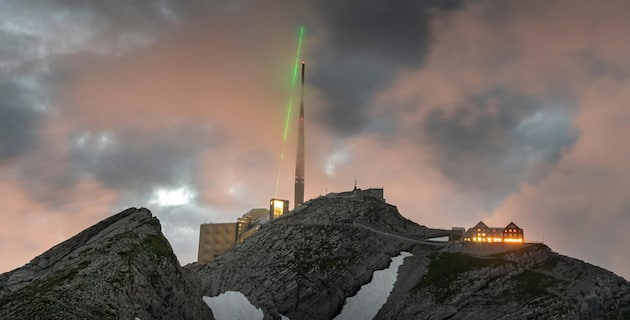Laser beam instead of metal rod: Laser beams directed into the sky can deflect lightning and thus serve as a lightning conductor, as a test on a Swiss mountain peak suggests. A pulsed high-power laser successfully deflected several flashes over a 124 meter high radio tower. The laser created an ionized, thinned-out channel in the air that the flashes followed, physicists report in Nature. This could open up new opportunities to protect, for example, airports, missile launch pads and other vulnerable infrastructure.
Lightning is one of the most spectacular phenomena of our weather. With up to a billion volts, the glaring discharges jump between thunderclouds or between clouds and the earth’s surface. In extreme cases, lightning can reach hundreds of kilometers. This creates a channel of ionized air molecules heated to up to 30,000 degrees, whose explosive expansion causes the thunder we can hear. Even antimatter and high-energy gamma rays are released in powerful flashes.
So far, buildings and other vulnerable infrastructure have been protected from impacts by grounded metal spikes on the roof. Invented by Benjamin Franklin around 270 years ago, these lightning conductors provide a preferred point of impact for lightning and conduct its charge underground. However, these lightning conductors are often not sufficient to shield extensive infrastructure such as airports, rocket launch pads or power plants over their entire area.
Aurélien Houard from the Polytechnic University in Paris and his colleagues have now developed and tested a possible alternative – flash deflection using a laser. Powerful laser pulses create a channel of ionized air molecules in the air, a so-called filament. “Along these filamentous zones, the air is rapidly heated by the absorption of the laser energy and expands outward at supersonic speeds,” the researchers explain.
This creates a channel that provides the lightning bolt with a path of least resistance—thus diverting it from its original target. “In the laboratory, electrical discharges that are several meters long have already been triggered and conducted by such laser-induced filaments,” report Houard and his colleagues. The laser pulses can be adjusted in such a way that the filament channel they generate begins far away from the laser source – this reduces the risk of lightning striking the deflection laser.
However, it was previously unclear whether this laser flash deflection also works in a real thunderstorm outdoors. That is why the physicists tested this in the summer of 2021 with an experiment on the Säntis in the Swiss Alps, which is around 2,500 meters high. To do this, they transported a high-power laser up the mountain, which can fire high-energy infrared laser pulses into the sky at a frequency of thousands of pulses per second.
The physicists aligned this laser in such a way that it beamed just over the top of a 124 meter high telecommunications tower on the mountaintop. “This tower, which is struck by lightning around 100 times a year, is equipped with numerous sensors that can register lightning discharges, electromagnetic fields, X-rays and other radiation caused by lightning,” the scientists report.
For their experiment, they switched on the laser whenever a thunderstorm was brewing within a three-kilometer radius of the tower. The laser then created a filament channel about 50 meters long above the top of the tower.
This is how flash deflection using laser beams works.
It turned out that during the test period, the tower was struck by lightning at least 16 times. The laser was active in four of these flashes, all discharges running from the tower towards the cloud. Analysis showed that these flashes actually followed the channel created by the laser and were thus deflected from their direct path. “The lightning strike follows the laser path over its approximately 50-meter-long path,” says the team. Only after the end of the laser-induced filament did the lightning resume its natural path.
“The results of the Säntis experiment campaign provide the first indications that the filaments formed by short, intense laser pulses can direct lightning discharges over considerable distances,” Houard and his colleagues state. Unlike conventional lightning conductors, the laser beams can deflect the lightning high up in the atmosphere – long before it gets close to the object to be protected.
The method still needs to be optimized and tested further. Nevertheless, the physicists see such laser lightning conductors as a promising way of better protecting critical infrastructure such as airports, power plants or rocket launch pads from lightning strikes in the future. (Nature, 2023; doi: 10.1038/s41566-022-01139-z)
What: Nature
This article was written by Nadja Podbregar
The number of immigrants in Germany is increasing massively – and with it the public debate. “Dispute over immigration: is Germany missing out on its future?” was the topic of the “hard but fair” program on Monday evening. It became particularly heated between Labor Minister Heil and Bavaria’s Interior Minister Herrmann.
After the escalation on Saturday, the police reported a success on Sunday: the protest village in Lützerath was completely cleared. Meanwhile, the activists are complaining of serious injuries – the police, however, denied this. The situation in Lützerath in the Newsticker.
The original of this post “Like in the movies! Laser beams guide thunderbolts” comes from scinexx.
